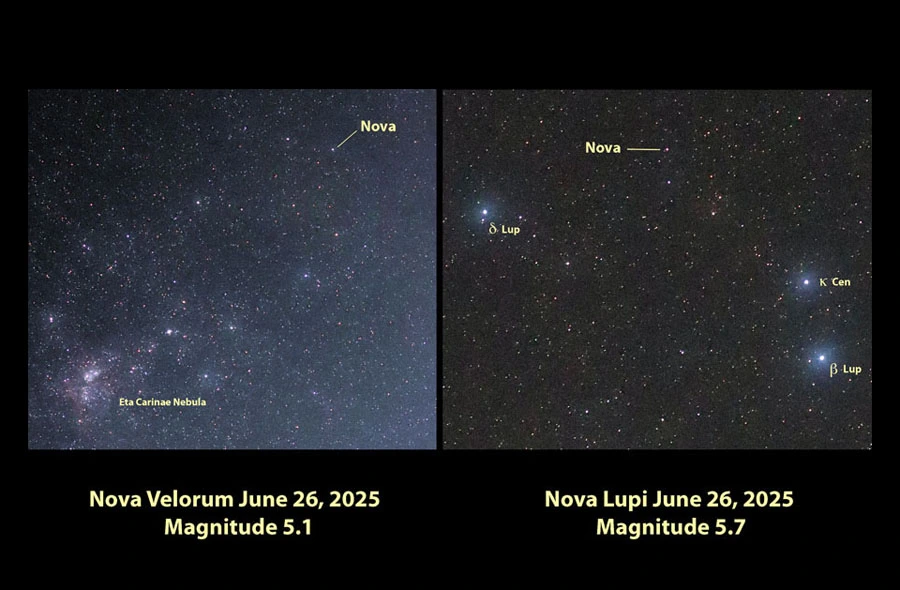Rarely have I felt so gratified. After Google-mapping to find an unobstructed southern horizon and then waiting for a cloudless night, I succeeded in observing Nova Lupi 2025 (V462 Lupi) from my location in Duluth, Minnesota. Although it stood only 2.5 ° high at the time, I came that close to seeing it in 10×50 binoculars. Fortunately, my 10-inch Dob made quick work of it. On June 28th, I estimated the nova’s brightness at magnitude 6.2.

NASA Goddard Space Flight Center
Although V462 Lupi is now past its peak visual brightness of magnitude 5.2–5.4, it’s in no hurry to leave the sky. On July 1st, the star still hovered at the naked-eye limit at 5.9. Visual observers have noted that the nova exhibits a warm yellowish hue, and my photo clearly shows its reddish color. This occurs for a couple of reasons — as the star’s thermonuclear fireball cools, energized hydrogen atoms emit a deep-red light called hydrogen-alpha as they return to their ground (lowest-energy) state. Also, the formation of dust within the expanding shell of debris reddens the starlight.
Naked-eye novae are uncommon, but two of them occurring at the same time is extremely rare. Yet, not two weeks after V462 Lupi came to light, John Seach of Australia bagged a second “new star” in Vela, the Sails, on June 25th with his digital camera. Upon discovery, it was already visible without optical aid at magnitude 5.7. Nova Velorum 2025 (V572 Velorum) appears to have peaked around 4.9 on June 26–28, and is currently fading, shining in the magnitude 5.7–6.0 range on July 1st. For observers in the tropics and Southern Hemisphere, they’re both still visible without optical aid from a dark-sky location.

Bob King
Sky & Telescope Contributing Editor Stephen James O’Meara wondered whether two simultaneous naked-eye novae had been observed in the past. After an extensive search through the American Association of Variable Star Observers (AAVSO) archives, he found just one instance in modern times.
“AAVSO light curves show that FM Circini (Nova Circini 2018) reached a peak brightness of magnitude 5.8 on 22 March 2018, and on that same day, V906 Carinae (Nova Carinae 2018) peaked at around magnitude 5.9. So, the two novae shared a similar naked-eye magnitude, albeit briefly,” said O’Meara via email.

Stellarium with annotations by Bob King

Stellarium with annotations by Bob King
That makes right now a rare opportunity for amateurs to witness a naked-eye novae duo. Of course, it helps if you live in the Southern Hemisphere, where both stars are conveniently placed high in the south-southwestern sky as soon as it gets dark. V572 Velorum is located in the southern Milky Way, 6.5° northwest of the Eta Carinae Nebula. While it’s possible to spot V642 Lupi from most of the U.S., the nova’s low altitude means you’ll need binoculars and a good view to the south-southwest to spot it at nightfall.
Nova Velorum is farther south yet at declination –53.5°. While it’s theoretically visible at 3.5° altitude from Atlanta, that’s only when the nova is near the meridian. However, that occurs while the Sun’s still up. Even from Key West it sets in twilight. It’s best to get on a plane and fly to Jamaica or the Cayman Islands, where you’ll see Vela’s newest resident plainly with binoculars about 5° high in late twilight. Pity it’s the wrong season — a trip to the tropics in winter would have been very tempting!
As you make your plans to see one or both, I leave you with this parting thought from O’Meara:
“[We] still don’t know if anyone actually looked for, and saw, FM Circini and V906 Carinae with their unaided eyes at the same time of night. They may have gone unnoticed. If so, it would make this current event even more special.”

